Phytotherapy and peptic ulcer disease
Peptic ulcer can be treated with herbal remedies only after a thorough medical checkup (X-ray imaging and gastroscopy) is conducted to rule out cancer and if there are no indications for surgical treatment.
The main purposes of phytotherapy in terms of peptic ulcer disease treatment are:
- Elimination of the disease symptoms;
- Improvement of the patient’s quality of life;
- Prevention of complications (perforation or bleedings);
- Detoxification of the body.
Being aware that peptic ulcer disease is of inflammatory nature it is reasonable to choose anti-inflammatory herbs as the basis for its treatment.
There are three main groups of anti-inflammatory herbs distinguished by the effects they provide:
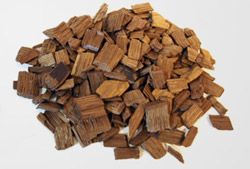 Medicinal plants that contain tannins and derivative of gallic acid. The anti-inflammatory action of these medicinal herbs is obtained by the direct contact of the mentioned substances with the gastric and duodenal mucosa. Having a tanning effect, the plants from this group contribute to the formation of a protective protein film on the surface of the mucosa. These are oak bark, alder cones (Alnus), tormentil root (Potentilla erecta), herb Bennet root (Geum urbanum), leaves and root of Siberian-tea (Bergenia crassifolia (L.) Fritsch);
Medicinal plants that contain tannins and derivative of gallic acid. The anti-inflammatory action of these medicinal herbs is obtained by the direct contact of the mentioned substances with the gastric and duodenal mucosa. Having a tanning effect, the plants from this group contribute to the formation of a protective protein film on the surface of the mucosa. These are oak bark, alder cones (Alnus), tormentil root (Potentilla erecta), herb Bennet root (Geum urbanum), leaves and root of Siberian-tea (Bergenia crassifolia (L.) Fritsch);
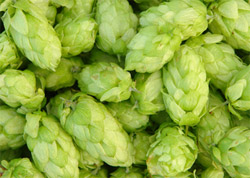 The second group includes plants that contain substances with cycle structure that resembles adrenal cortex hormones called glucocorticoids. Thus, their mechanism of anti-inflammatory action is also similar. But at the same time these plants don’t have the ulcerogenic effect of glucocorticoids. The members of this group are licorice (Glycyrrhiza glabra), common hop (Humulus lupulus), Greek valerian or Jacob’s ladder (Polemonium caeruleum), Aconitum baicalense, etc.
The second group includes plants that contain substances with cycle structure that resembles adrenal cortex hormones called glucocorticoids. Thus, their mechanism of anti-inflammatory action is also similar. But at the same time these plants don’t have the ulcerogenic effect of glucocorticoids. The members of this group are licorice (Glycyrrhiza glabra), common hop (Humulus lupulus), Greek valerian or Jacob’s ladder (Polemonium caeruleum), Aconitum baicalense, etc.
 The third group includes medicinal herbs that contain natural salicylates. These are willow bark, raspberry leaves, meadowsweet (Filipendula ulmaria (L.) Maxim.), marsh cinquefoil (Comarum palustre), Anomala Peony (Paeonia anomala), etc. It has long been known that salicylates (aspirin) and other NSAIDs (non-steroidal anti-inflammatory drugs) have a strong damaging effect on the gastric mucosa. Thus, the use of such drugs is strictly contraindicated in people who suffer from peptic ulcer disease. But as for the herbs that contain salicylates, we cannot make such a definite conclusion concerning their use. For example, willow and raspberry can provoke side effects, whereas meadowsweet and marsh cinquefoil rarely cause any. Probably the peculiarities of the chemical composition of these plants somehow ‘cancel’ the effects of the salicylates that are harmful for gastric mucosa.
The third group includes medicinal herbs that contain natural salicylates. These are willow bark, raspberry leaves, meadowsweet (Filipendula ulmaria (L.) Maxim.), marsh cinquefoil (Comarum palustre), Anomala Peony (Paeonia anomala), etc. It has long been known that salicylates (aspirin) and other NSAIDs (non-steroidal anti-inflammatory drugs) have a strong damaging effect on the gastric mucosa. Thus, the use of such drugs is strictly contraindicated in people who suffer from peptic ulcer disease. But as for the herbs that contain salicylates, we cannot make such a definite conclusion concerning their use. For example, willow and raspberry can provoke side effects, whereas meadowsweet and marsh cinquefoil rarely cause any. Probably the peculiarities of the chemical composition of these plants somehow ‘cancel’ the effects of the salicylates that are harmful for gastric mucosa.
If anti-inflammatory preparations have been chosen as the basis for the treatment, then analgesic agents should be brought to the fore in the tactical therapy
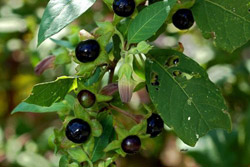 Pains caused by peptic ulcer disease are mostly of a spasmodic nature. Therefore, peptic ulcer treatment may involve herbal antispasmodics. Generally speaking, in the past treatment of this disease used to start with such herbs. And up until now these remedies are quite often used to quickly stop pain syndrome at hospital. This refers to atropine, the alkaloid of belladonna aka deadly nightshade (Atropa belladonna), and to platyphyllin, the alkaloid of senecio (Senecio rhombifolius). Mentioned medicinal herbs can be used in the treatment of gastroduodenal ulcers. In the case of belladonna, it should be kept in mind that this plant is poisonous and, thus, its use requires thorough dosing and medical supervision. As for its side effects, dry mouth is the most common one. It disappears once the dose of the herb is slightly lowered. Black henbane (Hyoscyamus niger) works similarly to belladonna.
Pains caused by peptic ulcer disease are mostly of a spasmodic nature. Therefore, peptic ulcer treatment may involve herbal antispasmodics. Generally speaking, in the past treatment of this disease used to start with such herbs. And up until now these remedies are quite often used to quickly stop pain syndrome at hospital. This refers to atropine, the alkaloid of belladonna aka deadly nightshade (Atropa belladonna), and to platyphyllin, the alkaloid of senecio (Senecio rhombifolius). Mentioned medicinal herbs can be used in the treatment of gastroduodenal ulcers. In the case of belladonna, it should be kept in mind that this plant is poisonous and, thus, its use requires thorough dosing and medical supervision. As for its side effects, dry mouth is the most common one. It disappears once the dose of the herb is slightly lowered. Black henbane (Hyoscyamus niger) works similarly to belladonna.
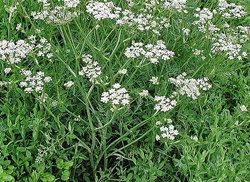 Also many plants from the Umbelliferae family have the same antispasmodic effect – caraway (Carum), fennel (Foeniculum), anise (Pimpinella anisum), dill (Anethum); their seeds are used. Marsh cudweed (Gnaphalium uliginosum) can also be used as an antispasmodic, it is a part of a classic antiulcer recipe of herbal medicine. The same effect is provided by the close relative of marsh cudweed - dwarf everlast (Helichrysum arenarium). Its antispasmodic effect is shown more clearly in relation to bile ducts. But it works for the stomach as well. Other antispasmodics are German chamomile (Matricaria chamomilla), wild mint (Mentha arvensis), common St. Johnswort (Hypericum perforatum), silverweed (Potentilla anserina), creeping thyme (Thymus serpyllum).
Also many plants from the Umbelliferae family have the same antispasmodic effect – caraway (Carum), fennel (Foeniculum), anise (Pimpinella anisum), dill (Anethum); their seeds are used. Marsh cudweed (Gnaphalium uliginosum) can also be used as an antispasmodic, it is a part of a classic antiulcer recipe of herbal medicine. The same effect is provided by the close relative of marsh cudweed - dwarf everlast (Helichrysum arenarium). Its antispasmodic effect is shown more clearly in relation to bile ducts. But it works for the stomach as well. Other antispasmodics are German chamomile (Matricaria chamomilla), wild mint (Mentha arvensis), common St. Johnswort (Hypericum perforatum), silverweed (Potentilla anserina), creeping thyme (Thymus serpyllum).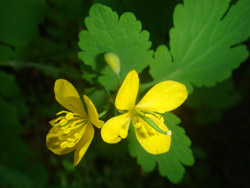 Analgesic effect of medicinal herbs can be obtained due to the procaine-like effect of their substances produced on the gastric and duodenal mucosa. In other words, herbs can work like a local anesthetic. Such effect can be observed in Greater celandine (Chelidonium majus), candle larkspur (Delphinium elatum), common comfrey (Symphytum officinale), poison hemlock (Conium maculatum), Venus' chariot or monkshood (Aconitum napellus). All plants from this group are poisonous! Therefore, their use requires great caution and special skills.
Analgesic effect of medicinal herbs can be obtained due to the procaine-like effect of their substances produced on the gastric and duodenal mucosa. In other words, herbs can work like a local anesthetic. Such effect can be observed in Greater celandine (Chelidonium majus), candle larkspur (Delphinium elatum), common comfrey (Symphytum officinale), poison hemlock (Conium maculatum), Venus' chariot or monkshood (Aconitum napellus). All plants from this group are poisonous! Therefore, their use requires great caution and special skills.
Special substances can help reduce gastric acidity, they are called secretion blockers (antisecretory agents). This category includes the already mentioned belladonna and black henbane. The same effect is produced by garden sage (Salvia officinalis), creeping thyme (Thymus serpyllum) and garden valerian (Valeriana officinalis). During the treatment of peptic ulcer disease it is highly important to provide a steady and prompt healing of the ulcerous defect of the mucosa.
Three groups of medicinal herbs are used for this purpose
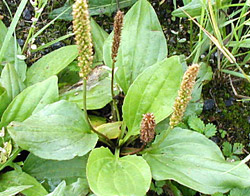
- Herbs that provide a lot of mucilage. Covering the stomach from the inside, mucilage protects ulcer from the further damaging action of hydrochloric acid, pepsin, hard food as well as the duodenal content thrown into the stomach from the duodenum (reflux gastritis). This group includes common plantain (Plantago major), flax seeds (Linum), Iceland moss (Cetraria islandica), common mallow (Malva neglecta Wallr.), garden angelica (Angelica archangelica), common marshmallow (Althaea officinalis). There is also an old recipe – 1/3 cup of a fresh potato juice to be drunk before meals. Potato should have a pink peel; it should be washed in cold water with a brush, scalded with boiling water and then ground in a meat grinder together with its peel.
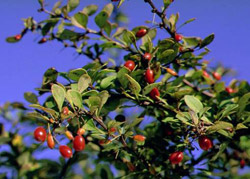
- Herbs that have antimicrobial effect (to fight Helicobacter pylori) and can clean the ulcer from the necrotic masses. These are common yarrow (Achillea millefolium), creeping thyme (Thymus serpyllum), European barberry (Berberis vulgaris), Saussurea salicifolia, birch leaves, lady's mantle (Alchemilla vulgaris), kalanchoe (Kalanchoe pinnata), common St. Johnswort (Hypericum perforatum), sweetflag (Acorus calamus), marsh cudweed (Gnaphalium uliginosum), etc.
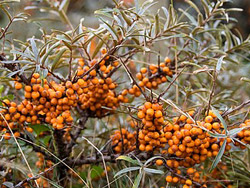
- Herbs that improve regeneration of the mucosa (wound healing). These are candelabra aloe (Aloe arborescens), sea buckthorn (Hippophae rhamnoides), stinging nettle (Urtica dioica) and common yarrow (Achillea millefolium). The last two herbs can be used together with shepherd's purse (Capsella bursa-pastoris) if gastric bleeding is suspected. In such situation it is recommended to take the decoction, put a hot-water bottle filled with ice on the stomach and call a doctor immediately!
Adaptogens and Calming Herbs
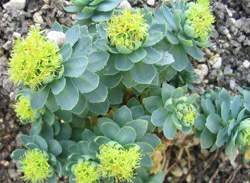 When talking about regenerative herbs, it is worth mentioning the use of plant adaptogens that improve regeneration process in the gastric mucosa. These herbs include ginseng, roseroot (Rhodiola rosea), maral root (Rhaponticum carthamoides), Siberian ginseng (Eleutherococcus senticosus (Rupr. & Maxim.) Maxim.). Peptic ulcer disease is almost the only case when these herbs should be taken not as a tincture but as a decoction.
When talking about regenerative herbs, it is worth mentioning the use of plant adaptogens that improve regeneration process in the gastric mucosa. These herbs include ginseng, roseroot (Rhodiola rosea), maral root (Rhaponticum carthamoides), Siberian ginseng (Eleutherococcus senticosus (Rupr. & Maxim.) Maxim.). Peptic ulcer disease is almost the only case when these herbs should be taken not as a tincture but as a decoction.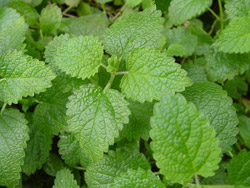 And, finally, the last group of herbs that are useful for peptic ulcer includes calming herbs. Quite often relapse of peptic ulcer disease is provoked by emotional stress. In this connection the use of sedative remedies is one of the most important directions in the treatment of this disease. Therefore, calming herbs are usually included in herbal mixes. The examples of such medicinal plants are garden valerian (Valeriana officinalis), balm mint (Melissa officinalis), wild mint (Mentha arvensis), marsh (Labrador) tea (Ledum palustre), oregano (Origanum vulgare), redhaw hawthorn (Crataegus sanguinea) and lavender.
And, finally, the last group of herbs that are useful for peptic ulcer includes calming herbs. Quite often relapse of peptic ulcer disease is provoked by emotional stress. In this connection the use of sedative remedies is one of the most important directions in the treatment of this disease. Therefore, calming herbs are usually included in herbal mixes. The examples of such medicinal plants are garden valerian (Valeriana officinalis), balm mint (Melissa officinalis), wild mint (Mentha arvensis), marsh (Labrador) tea (Ledum palustre), oregano (Origanum vulgare), redhaw hawthorn (Crataegus sanguinea) and lavender.
Here are some possible recipes of herbal teas
Herbal tea 1 (to reduce inflammation and start healing)
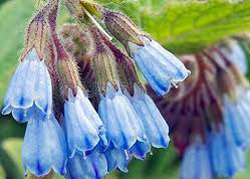
- Common comfrey (root) 1 part
- Common marshmallow (root) 1 part
- German chamomile (flowers) 1 part
Take 5 ml (0.17 fl oz) of tincture 3 times a day. In addition, drinking chamomile infusion on an empty stomach can help reduce inflammation as well as reverse ulcerative process.
Herbal tea 2 (to complete healing)
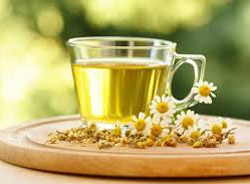
- German chamomile (flowers) 2 parts
- Goldenseal (Hydrastis canadensis) 1 part
- Common comfrey 2 parts
Take 5 ml (0.17 fl oz) of tincture 3 times a day.
Herbal tea 3 (to treat peptic ulcer disease)
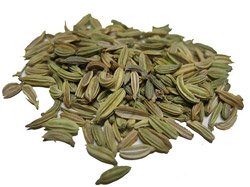
- Fennel (seeds) 1 part
- Common marshmallow (root) 1 part
- German chamomile (flowers) 1 part
- Licorice (root) 1 part
- Quackgrass (Elymus repens (L.) Gould) (root) 1 part
2 tablespoons of the dried blend should be mixed with 1.5 cups of boiling water and left for 3 hours to infuse, then passed through a sieve. Take it as follows - 1 cup an hour after evening meal.
Herbal tea 4 (the same medicinal plants as in the treatment of chronic gastritis with increased production of hydrochloric acid are used during exacerbation as well as to prevent relapse of peptic ulcer)
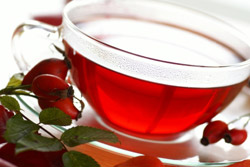
- Common plantain (leaves) 2 parts
- German chamomile (flowers) 2 parts
- Rose hips 1 part
- Marsh cudweed (herb) 2 parts
- Common yarrow (herb) 1 part
10 g (0.35 oz) of dried herbs should be mixed with 500 ml (16.9 fl oz) of boiling water and left for 5-6 hours to infuse. The remedy should be taken as follows – 100 ml (3.38 fl oz) 3 times per day before meals.
Herbal tea 5 (during acute and subacute stages of peptic ulcer disease (1st – 3rd weeks))
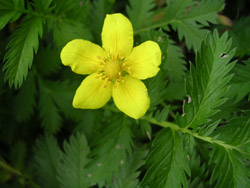
- Common St. Johnswort (herb) 1 part
- Silverweed (root) 1 part
- Pot marigold (Calendula officinalis) (flowers) 1 part
- Mint (leaves) 2 parts
- Stinging nettle (leaves) 1 parts
15 g (0.53 oz) of dried herbs should be mixed with 1 cup of boiling water and left for 30-40 minutes to infuse, then passed through a sieve. Take 50 ml (1.70 fl oz) of the infusion 4 times a day before meals.
Herbal tea 6 (during scarring and epithelialization periods (4th – 5th weeks))
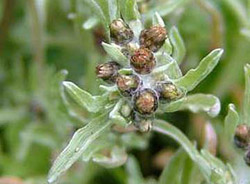
- Common plantain (leaves) 2 parts
- Rose hips 1 part
- Marsh cudweed (herb) 2 parts
15 g (0.53 oz) of dried herbs should be mixed with 1 cup of boiling water, left for 30-40 minutes and passed through a sieve. Take the infusion as follows – 50 ml (1.70 fl oz) 4 times per day before meals.
Herbal tea 7 (for hyperexcitability, anxiety, sleep disturbances)
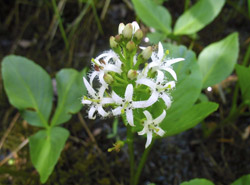
- Mint (leaves) 2 parts
- Buckbean (Menyanthes trifoliata) (leaves) 2 parts
- Garden valerian (roots) 1 part
- Common hop (cones) 1 part
5 g (0.18 oz) of dried herbs to be mixed with 1 cup of water, heated using boiling water bath for 20 minutes, left for 20 minutes to infuse and then pressed out. 100 ml (3.38 fl oz) of the infusion should be taken 3 times per day before meals.
The two following herbal teas should be interchanged every 10 days for 2-3 months if there are marked pains or heartburn:
Herbal tea 8
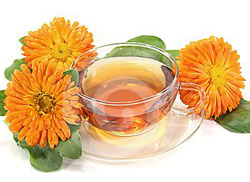
- German chamomile (flowers) 1 part
- Pot marigold (flowers) 4 parts
- Coltsfoot (Tussilago farfara) (leaves) 4 parts
5 g (0.18 oz) of dried herbs to be mixed with 1 cup of water and heated using boiling water bath for 15 minutes, then left for 45 minutes to infuse. Take the remedy as follows – 1-2 tablespoons 3-4 times a day before meals.
Herbal tea 9
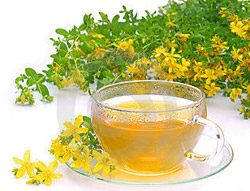
- German chamomile (flowers) 1 part
- Common plantain (leaves) 4 parts
- Common St. Johnswort (herbs) 4 parts
5 g (0.18 oz) of dried herbs should be mixed with 1 cup of water, heated using boiling water bath for 15 minutes, then left for 45 minutes. The remedy should be taken as follows – 1-2 tablespoons 3-4 times per day before meals.
Herbal treatment should last at least 2 – 2.5 months in case of peptic ulcer disease exacerbation and at least 1 month for preventive purposes in spring and fall.
Patients with complicated forms of peptic ulcer disease require urgent hospitalization. It is important to check whether there are any indications for urgent (perforation, bleeding) and elective (organic stenosis, penetration, neoplastic transformation) surgeries.
Undue use of phytotherapy in such cases is inacceptable!
